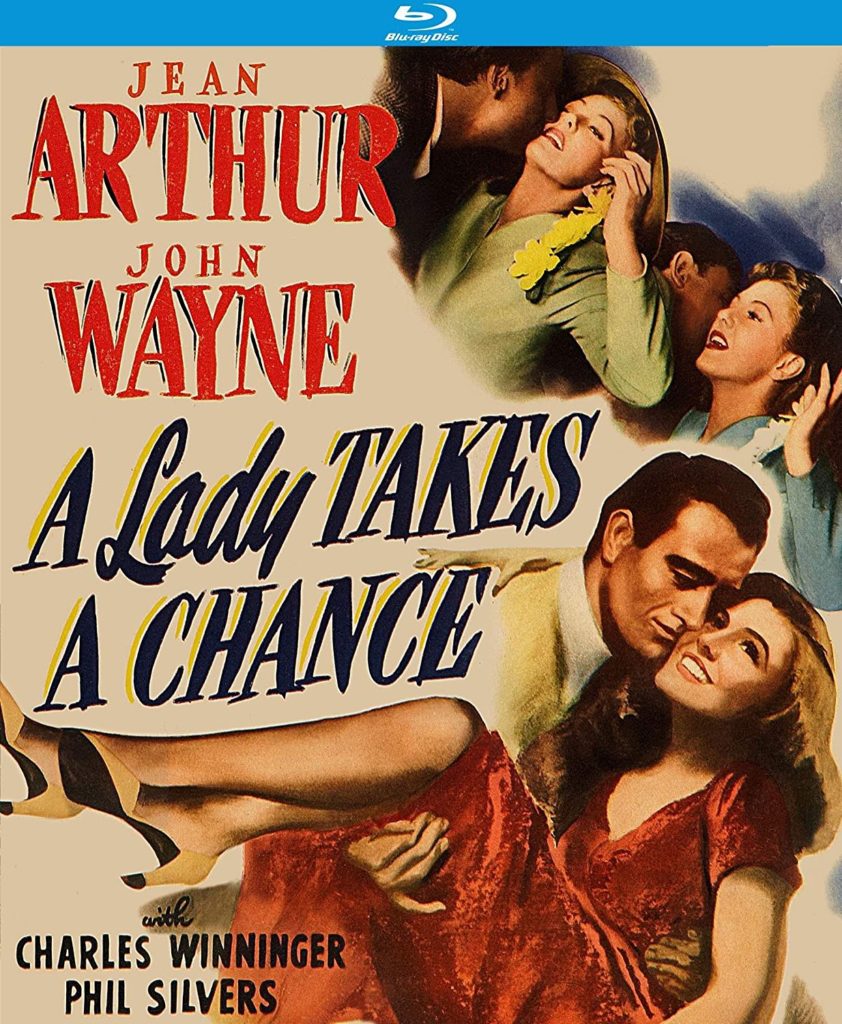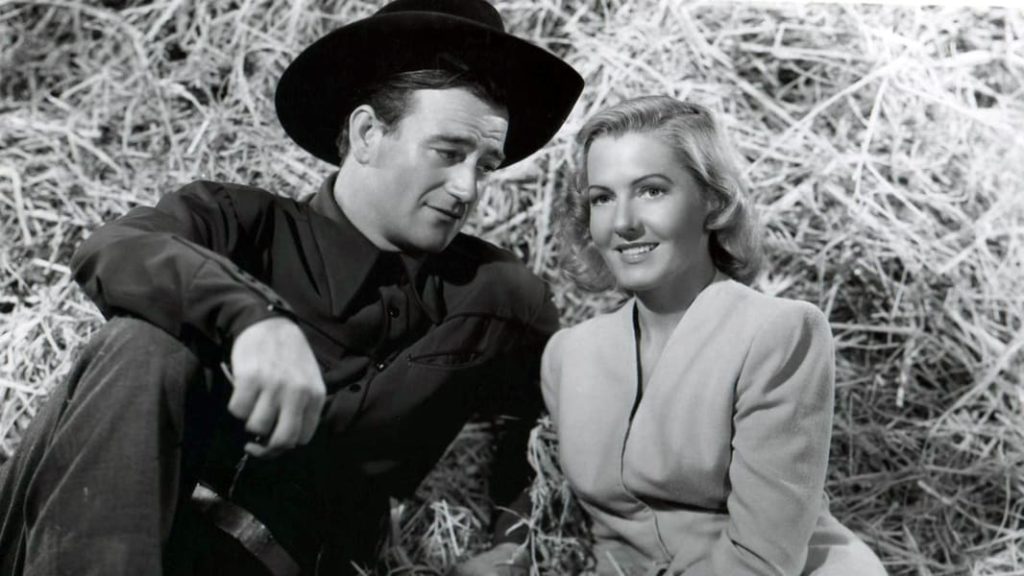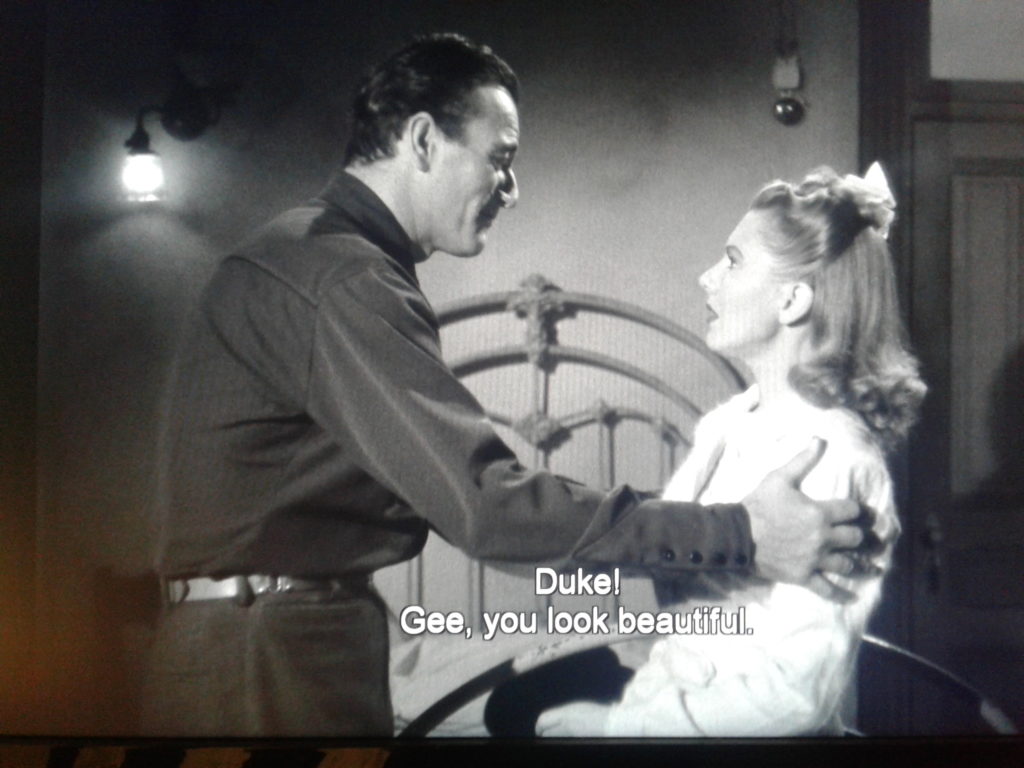Taking A Chance On Young John Wayne And A Fetching Jean Arthur
DIRECTOR: WILLIAM A. SEITER/1943
STREET DATE: MAY 15, 2018/KINO LORBER STUDIO CLASSICS

Blu-ray cover image for Kino Lorber’s release of A LADY TAKES A CHANCE; seemingly quite “frisky”, even for its day!
Growing up, you tend to assume the responsible adults you encounter have always been both responsible and, well, adult. Respect, you feel, naturally arises from the dignified behavior and unyielding confidence of those in positions of authority over you. Occasionally, though, you may get tantalizing glimpses of the irresponsible kids they once were, and the veil of rectitude sweeps aside to reveal the inner recesses of doubt, unruliness, and plain wrongness that give the lie to any such high-minded notions of maturity.
As a f’r instance, a wide-eyed view in a fading Polaroid album of one’s parents as game youngsters, attending a mid-70s nude “body painting” party, may prompt reminiscence from both parties about the time one’s father was punched out by a much bigger and stronger guy during a drunken brawl. As a further f’r instance, an innocent question posed to one’s grandparents about the heavily-taped end of an old, out-of-tune ukulele could suddenly and irrevocably shift one’s equally innocent perception of a sweet, older couple – who sleep in matching twin beds, for gosh sakes – when revealed that Grandma, in a fit of youthful, jealous rage, smashed the unoffending instrument over Grandpa’s now-bald, -tender noggin.

reverse-cover image from Kino Lorber’s upcoming Blu-ray; emphasizing co-star Jean Arthur’s “sexy” new image
Given the unique qualities of film, particularly the relation of passing time to frozen-in-time images, one is occasionally given a new and entirely different view of an established screen figure, star, and icon – and our co-starring actor under discussion was certainly all of these – when seeing an earlier role for the first time. Charming, energetic, youthful; it’s one thing to imagine someone whose nickname is The Duke acting (or I should say “behaving”) like a kid, but to virtually experience those qualities in 86 minutes of romantically comic screen time is a rare treat indeed.

As such, the mature screen authority John Wayne intrinsically projected throughout his 50-year film career, especially in those more complex roles taken after the mid-40s, is rather entertainingly undercut in the early-career romantic comedy A Lady Takes A Chance. Produced by RKO, directed by comedy veteran William A. Seiter (Laurel & Hardy’s Sons of the Desert [1933]), and co-starring the Reigning Queen of Screwballs, Jean Arthur, the Chance of the title – along with its odd resonance with a later mature role for Wayne; the ne plus ultra of responsible authority – shows a younger, irresponsible, uncertain, and sometimes plain wrong Wayne character groping – sometimes quite literally and uncomfortably so – towards screen maturity.

taken from my phone (apologies for the blurriness): a young Duke (Wayne) getting a bit “handsy” with a ‘shocked’ Miss Truesdale (Arthur).
Without going through his entire 170-movie credit list, I might observe, as merely a point of interest, that this is one of maybe a handful of roles where The Duke is on-screen called “Duke”. As Duke Hudkins, roving and roving-eyed rodeo rider, the unformed and sometimes too-forward western man-boy encounters Southwestern-vacationing New York City gal Molly J. Truesdale (Arthur; still quite tomboy-ish despite the added glamor-izing of the role). Three or four plot complications later, the saloon meet-cute and subsequent cactus-and-sagebrush roadtrip – where Duke’s western sensibilities are near-mortally offended when poor Molly unthinkingly steals his cold-prone horse Sammy’s blanket one prairie evening – eventually resolves to the tall cowboy (literally) whisking off the tiny lady (unresistingly) at an NYC bus terminal.
A satisfying film all around, the romantic comedy elements – with enough entertaining screws jammed in to make it all palatable – are imaginatively grafted onto the modern western milieu (re-set, as we are informed in a prologue, to slightly before wartime, so as to explain why a healthy young male would not be overseas; a real-life dilemma, parenthetically, for the then-35-year-old Wayne) and fans of the glorious art of character acting will spot Phil Silvers, Mary Field, Hans Conried, Grady Sutton, and Wayne movie mainstay Grant Withers – among many others – giving shape and substance to the western screwball romantic comedy setting. Special mention in this regard should be made to Charles Winninger as Wayne’s western-show pardner Waco, his expert essay of the wise ol’ galoot a film-length delight.
Returning to the opening paragraphs, the inevitable sparks between Molly and Duke – possibly off the latter’s boot-tramping spurs – occasionally fly rougher than one might find comfortable, especially from a latterday perspective, but the good, easy nature of both performers shines through with the full force of Jean Arthur and John Wayne’s combined star power. Arthur, teasing out the more sexualized characteristics previously unexplored in her established screen persona (her attempt, while hitchhiking, at pulling a Claudette Colbert-inspired gam-stop of a passing vehicle falling hilariously flat, alas), and Wayne, coltishly pursuing a good-looking girl while unknowingly experiencing a more mature and lasting regard (the growing respect, alas and alack, not extending towards the unthinking offer of a suggestively after-hours nightcap), together give an inspired younger-days view of two formidable screen presences.
With Kino Lorber’s soon-available Blu-ray presentation (no special features beyond a few western- and comedy-themed trailers, alas, alack, and alay, but still looking great in high-def), one can definitively say that the fictional story-descendants of this hilariously mismatched pair of a city gal and western gent will get a mighty kick out of seeing their movie grandparents acting like a pair of young fools.
Further apologies for the lack of images throughout; those where otherwise uncredited are used only as a reference to the film and are not meant to reflect the image quality of Kino Lorber’s Blu-ray release.

